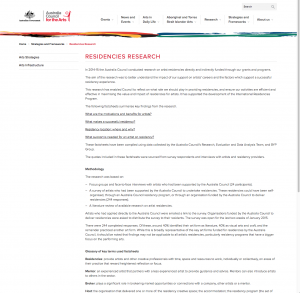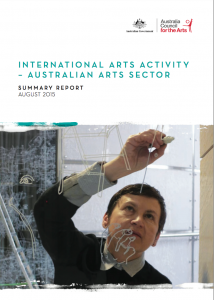Due to my data nerd status, I was invited to be part of a few talks this year about the arts and disability. People have since asked me for the data I mentioned at these talks so I have compiled my favourite data takeaways here.
At these talks, I always acknowledge that I do not have lived experience of disability (I do as a carer, but I know that is not the same thing at all). I am not an expert on the disabled experience of (under-) representation, and I come to these talks from a position of not-knowing, and learning more than I can give. What I can offer is my experience with data and research. Here it is.
Accessible Arts ATAG Breakfast, Nov 12 2019, Roslyn Packer Theatre, Sydney. Jeremy Smith from the Australia Council for the Arts, me, Stuart Buchanan from the Sydney Opera House, and our Auslan interpreter.
What we know
Attendance: The Australian National Arts Participation Survey 2016 showed that proportionally, people with disability attend the arts as much as people without disability – sometimes more so (dance, visual arts, literature events and festivals)
Creative participation: The survey also found that people with disability are now more likely to create art (61%) than people without disability (44%). This is the case for visual arts and craft, dance, theatre and creative writing (Connecting Australians 2017)
Volunteering: 24% of people with disability have done volunteer or unpaid work in the arts, or helped out artists or community groups with arts activities, compared to 14% of Australians without disability (CMC Report 2018). ‘Voluntary’ work is an issue for the arts in general and possibly especially for people with disability (DADAA).
Philanthropy: Although 49% (almost half) of people with disability are in the lowest two income quintiles, as a cohort they are more likely to give money to the arts (21% compared to 9%) (CMC Report 2018) Probably because of higher proportion of arts-goers and donors amongst older Australians)
Professional arts practice: According to the latest Throsby report, Making Art Work, artists with disability are under-represented, earn less than their counterparts without disability, experience unemployment at higher rates, and are more likely to identify a lack of access to funding as a barrier to their professional development.
Artists with disability earn on average 42% less than their counterparts
One third of artists with disability experienced unemployment compared to one quarter of artists without disability (general population: unemployment rate 5%, compared to 10% for people with disability – CMC Report 2018).
18% of Australians had disability in 2015 (4.3 million). By comparison, 9% of practising professional artists identify with disability, with variations across artforms e.g. 6% of actors and directors compared to 14% of CACD artists. This may reflect the lower rate of labour force participation of people with disability (53% of people with disability were in the labour force, compared to 83% of people with no disability. However, there was a lower rate of people who need core activity assistance amongst those working in creative industries or creative roles than in the wider labour force – this increased from 2011 to 2016 in line with other industries. This could indicate that some of the issues may be industry-specific and not just a reflection of wider systemic barriers.
Artists with disability were far more likely to cite disability/injury/sickness as one of the most important factors inhibiting their professional development than other artists (about 18% compared to about 3%)
Funding applications: Of the Smartygrant applications made to the Federal Department from 2015, 24% were disability-led or employed people with disability. 31% of applications were approved: the same success rate as other applications. But we don’t know if this is the case across all agencies.
Artists with disability apply for financial assistance at the same rates as artists without disability, but are more likely to identify a lack of access to funding as a barrier to professional development (we don’t know whether they have a lower success rate)
Screen: Just 4% of main or recurring TV characters were portrayed as having an identifiable disability in Australian TV drama productions from 2011-2015 (Seeing Ourselves 2016) – 71 characters in total, out of the 1,961 total main characters. 25 characters had physical/sensory disabilities, and 47 had neurological, cognitive and/or other intellectual disabilities
Just 10% of programs included at least one character with disability among the main characters (20 programs in total)
For the titles that had main characters with disability, those characters accounted for 4% of the program’s main characters
Most of the characters with a disability appeared on Neighbours or Home and Away (77%). In these shows, the characters’ disabilities were not a “normal” part of the fictional world, but were introduced to drive storylines for dramatic effect e.g. memory loss, blindness, paralysis, psychosis
Characters with disability were less likely to have legal and medical, leadership or criminal roles than characters without disability
Other relevant data:
Professional artists with disability are more likely to live in rural areas (17%) than artists without disability (8%)
89% of professional artists with disability feel that disability affects their creative practice at least some of the time.
Disability becomes more common with age: 10% of people aged 5-14 compared to 60% of people aged over 60.
People who require assistance with one or more core activities represent 59% of people with disability. There were 4,321 people with this need in creative/cultural occupations and 3,063 in creative and cultural industries. Proportionally this is lower than for all occupations and industries in Australia. However, this rate has increased since 2011 Census, in line with the trend across all industries and occupations. These numbers do not reflect the total number of people with disability in creative and cultural occupations and industries (CMC Report 2018).
Intersectionality can compound barriers. For example:
First Nations people experience disability at a significantly higher rate than the rest of the population
Migrants from NESB and refuges may face additional stigma and disadvantage
People born overseas are less like to access support services (Creating Pathways)
Actors with disability face casting barriers. Actors without disability will often be cast to play characters with disability, but the reverse is rarely true. However, casting more actors with disability is driving new audiences through commercial opportunities of “authentic casting” and diverse roles (Seeing Ourselves).
Research insights on support for artists with disability
Creating Pathways found that it is crucial for artists with disability to have ownership and agency over their work.
Creating Pathways highlights the importance of visible success stories, role models and mentors, and this recurs throughout literature on arts and disability. Role models and mentors provide inspiration for their peers and demonstrate the capability for leadership for other artists with disability.
Negative attitudes and low expectations are barriers to professional practice (CMC Report 2018)
Relationships and networks are also crucial for artists with disability to maintain sustainable work.
The evaluation of the Australia Council’s Arts and Disability funding initiative noted that the elements most valued by artists with disability were: the ability to budget for access requirements; peer assessors who understand the experience of disability; and accessibility features including the ability to submit applications in multiple formats.
Other research has highlighted the importance for arts governance to be accessible, particularly in making physical meeting spaces accessible and in arts workers undertaking disability awareness training. Governance processes can often be ineffective or even ‘hostile’ for artists with disability.
What we don’t know:
Representation of artists with disability amongst screen / arts key creatives i.e. writers, directors, producers
What % of applications across funding bodies are disability-led and are successful?
What % of people with disability would like to work professionally in the creative sector but have been unable to do so – what is the extent of the problem?
My key data sources are:
The Australia Council for the Arts Arts and Disability Research Summary - this is great, and brings together a lot of different sources
Creating Pathways - qualitative research by the Australia Council for the Arts
Seeing Ourselves - Screen Australia research on representation
The National Arts Participation Survey - an excellent resource on participation levels in the arts
Thanks to Accessible Arts and SAMAG for inviting me to be part of your events.



